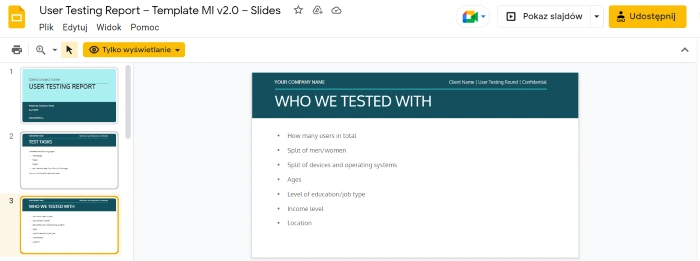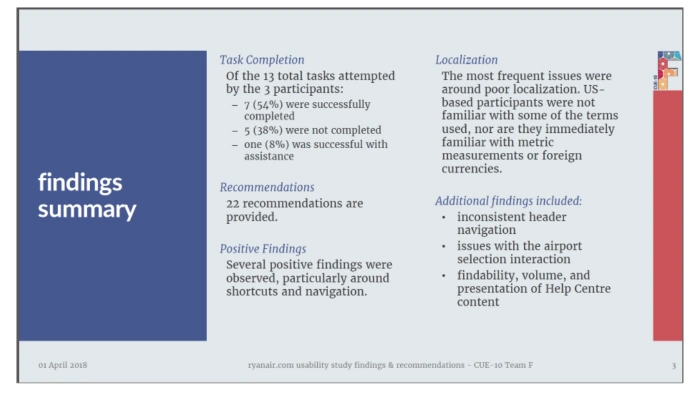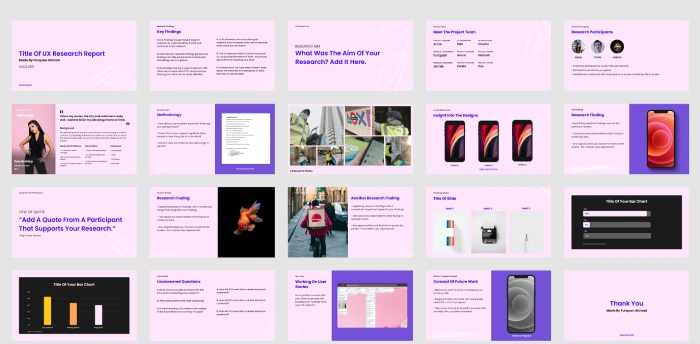If we type keywords into the search box, such as — UX report or UX research report example — we'll access many examples of UX research report templates.
Do they all carry some value? Unfortunately, no.
Contrary to what people may think, a research report — especially a qualitative one — is governed by its own laws, which we should know and obey.
The research report is an important document summarizing the findings of a research project that many stakeholders will treat not just as another corporate document but as a working tool.
Of course, as long as its author considers the specific needs of the report's audience during its preparation.
Therefore, questions like: How to write a research report? What does it need to include? How to prepare it correctly? Become very important.
The more fundamental question is: What is a research report? Determining the term, defining what a UX research report is, and indicating its subject matter and scope of applicability help us understand its functions much better.
By knowing and understanding the characteristics and functions that UX research reports carry, we can understand their importance. We'll also be able to prepare them in a way that will make them more useful.
If you're curious about how to write a qualitative or quantitative research report, what a UX research report should be, and what form it shouldn't take, read this article.
Enjoy!
What is a UX research report?
Every UX or user research ends at some point.
No less important than the research results is how these findings, data, and conclusions are communicated, presented, and conveyed to various stakeholders. The research team is responsible for creating a UX or user research report.
A research report is usually a document in which a researcher or team of researchers summarizes and communicates to stakeholders the following:
- UX or user research findings
- Collected data
- Used research methods
- Applied research tools
- Results of analysis and interpretation
Although informal and somewhat anecdotal, Dmitrij Korżow's article "How to make a strong research report" proposed a fascinating definition of a UX research report.
According to it, a good research report tells its recipient, the reader, what they didn't know before. Of course, the word good is very general.
A slightly more specific approach to the problem of report quality was taken by Polish authors Iga Mościchowska and Barbara Rogoś-Turek.
In their book "Badania jako podstawa projektowania User Experience" (Research as a Basis for User Experience Design), they point out that every research report must be created with its audience in mind.
The research report's creator is always responsible for its communicability, comprehensibility, accessibility, and attractiveness.
We can say, half-jokingly and half-seriously, that there are no terrible audiences for UX reports. There are only incomprehensible, obscure, complicated, chaotic, boring, over-explained, or overly concise research reports.
So, what should be done to make a user research report accessible and attractive to its diverse audience?
It's necessary to consider three factors:
- Audience
- Available time
- The extent of the researcher's participation in the project
Recipients have different competencies, are familiar with the project to varying degrees, and represent various interests and goals. Thus, they have very different attitudes to the research results and expectations.

Time is an important variable, as its availability makes it possible to refine the presentation of research results in terms of visuals, which always increases attractiveness but simultaneously is time- and work-intensive.
The less the researcher participates in the research, the more communicative and understandable the report should be.
Communicability, a kind of obviousness, will make it not a "dead" document demanding a "translator."
Instead, it will be a document that won't require additional explanations from its creator. We'll be able to read it and use it without consultation.
Functions of a UX research report
As we mentioned above, the research report is a tool.
At the same time, it's a tool with a unique role because it is addressed to different audiences and, therefore, must meet various needs and account for multiple uses.
The most essential functions of a research report include the following:
- Documenting data, conclusions, results, analyses, and interpretations
- Documenting methods, techniques, and tools
- Clear, understandable communication of information and explanation of results
- Presenting data, information, and conclusions in an attractive way (usually visual and textual)
- Converting results into knowledge, that is, giving meaning to the data
Regardless of the type of audience receiving a UX research report, its most important function is to provide knowledge and arguments that will be useful in the decision-making process.
A research report should also be helpful in the short and long term.
Research—including UX research—is cumulative, and historical research reports are a valuable source of knowledge and inspiration.
They also provide guidance (not always explicitly) on organizational issues related to the specifics of respondents and challenges that research imposes on UX researchers.
In addition, the research report should help empathize with and understand users. It should provide key insights into the needs and motivations of diverse teams, not just the design team (UI/UX design).

UX research reports help researchers:
- Communicate UX research findings and conclusions in a way and form that is easy to understand by people with little or no research competencies
- Communicate new research problems and new problem areas that should find understanding among stakeholders
- Create a list of recommendations
- Briefly and quickly communicate results, which is especially important in the iterative model of digital product development
- Accumulate helpful knowledge that can be used in the future
- Improve the way researchers communicate with stakeholders
Research reports for UX/UI designers, business owners, and department employees should be helpful.
They should bring value to their work and simplify it — to a greater or lesser extent.
However, we must remember that we shouldn't reduce UX research reports to conclusions alone.
Autumn Gilbert's article "Quality reporting is the key to realizing the full ROI of actionable UX research" reminds us of the broader context of report functions.
Gilbert straightforwardly writes that reporting is more than just a summary of results.
Reporting also:
- Accounts for contextual considerations, obstacles, barriers, and any unforeseen situations that, when described, are a valuable resource for researchers in the future.
- Allows us to compile characteristics of given groups of respondents — to describe the challenges the researcher must face.
- Gives a clear answer to the key question: Why?
- Provides conclusions, which can't replace the decision-making process, although they're an important part of it.
Characteristics of a helpful research report
In a standard research report, we can find the following fixed elements:
- Abstract, summary (executive summary)
- Descriptions of methods, techniques, and tools
- Descriptions and characteristics of the respondents
- Presentation of the results
- Discussion of the results
- Research questions
- Key findings
- Appendix
- Review of literature
There is also a much more concise format for a UX report, which contains only three main elements:
- Research review
- Results
- Next steps
The content of the various parts depends as much on conventions as on the researcher's ability to present research findings appealingly.
Undoubtedly, the report's form (e.g., slide presentations, PDF files, simple written reports), the types of messages it will contain (verbal, graphic, animated, photographic, audiovisual), and how these messages will be presented determine everything.
An attractive UX research report shouldn't lack the following:
- Illustrations
- Data visualization
- Examples, quotes
- Explanations
- Definitions
- Diagrams
- Tables
- Charts, models, graphical representations of mechanisms, processes
- Suggestions and links to sources (e.g., other research in a given research area, on a given topic)
However, it's worth remembering that different stakeholders have different expectations and preferences.
In every organization, we can find fans of hard data, charts, and bars and people who are more persuaded by the conclusions drawn from these figures, charts, and graphs.
Humanizing quantitative data and concretizing qualitative data is always a good thing. Quantitative data often seems dry and devoid of emotion, while qualitative data, on the other hand, is perceived as unmeasurable and recognized as illustrative.
When creating a UX research report, make sure it's:
- Clear, transparent, and logical
- Readable and scannable
- Informative and substantive
- Comprehensible and communicative with all kinds of legends, footnotes, explanations, hints
- Complete — the report should contain all the information necessary to verify the correctness of the research performed in terms of methodology and to replicate the study; it should also clearly separate data from their interpretation and information, results from their analysis
- Self-critical — the report should acquaint the reader with the full spectrum of results, with what was successfully investigated and what the study failed to investigate; any omissions or understatements aren't recommended.
Remember that the report won't be equally important to everyone. Different stakeholders usually familiarize themselves with the content of the reports to varying degrees.
Reading reports from cover to cover is more like wishful thinking than a practice we can encounter in companies.
With that said, there is no need to be offended by work colleagues. It makes much more sense to make their lives easier and divide the report into parts, sections, chapters, or fragments relevant to particular audiences.
It's also worth repeating critical information in condensed form rather than referring people to read entire paragraphs.
Information accessibility should also be ensured by considering the readability of reports on different devices and in different presentation forms.
For example, on desktop computers and mobile phones, screens and projector screens, video projectors, and — last but not least — traditional printouts on paper.
The way the report is shared matters, and this affects the following:
- The number of people that will find out about its existence.
- The number of people that will read it.
- The number of people who can absorb and remember the key information.
Hence, the channel and form of the report's distribution and presentation should always be addressed. In this regard, we have several dominant methods.
A UX research report can be:
- Presented directly face-to-face and/or remotely
- Sent directly to the recipient (via an e-mail or instant messaging) or offered for download from a publicly available or authorization-requiring repository.
In terms of accessibility and efficiency of distribution, we should be guided by the principle of the most straightforward solutions. At the same time, we should provide the most convenient and natural method for the report recipients.
Another significant element that determines the effectiveness of a report's communication is its length.
As a rule, a UX research report shouldn't be:
- Too long, wordy
- Too short, incomprehensible, and therefore, too hermetic.
It may seem that we're talking about squaring the circle. Yes and no. It all depends on the experience of the person writing the report and on knowing the recipients' needs, expectations, and habits.
The report is helpful not always by itself but always for someone at a particular moment of the development of the project, company, or team. It's supposed to answer questions that are important to its audience.
A report that is too long can be discouraging, and it's easy to lose its meaning. The level of meticulousness should always be a function of the usefulness of the information.
Prioritizing information is paramount, as it allows us to write a detailed report with an audience in mind who isn't expected to expand their knowledge but to be able to use their new knowledge. Perform their tasks thanks to it.
Regarding the length of the report, it's worth heeding the advice of the authors quoted above — Iga Mościchowska and Barbara Rogoś-Turek, who make it clear that the most important thing is to make the report concise, neatly written, on-topic, reader-friendly and relevant to the audience.
The accessibility of UX research reports also refers to their linguistic accessibility and comprehensibility. Jargon, colloquial, and overly poetic language don't help gain attention and understanding of the content.
The standard structure of a research report
Let's start with the obvious. There is no single UX research report template, model, or way of writing it.
There are fixed components, but the nature of the research, stakeholder expectations, and a researcher's personal preferences largely dictate their configuration, scope, and content.
In its most trimmed version, which in many situations is helpful as well as advisable, a report can consist of three parts:
- Study overview
- Research findings
- Next steps
This is precisely the model discussed in the article "Writing a user research report: tips and template slides."
The study overview, the introduction is the part where the author of the report describes and explains the following:
- What was studied?
- Why was it studied?
- What the result of the study was?
In the overview, we should describe and explain the study's background, scope, methodology, and respondents' characteristics.
In the study's findings section, the reporting person introduces the stakeholders to the new data, information, and knowledge gained from it.

The next steps section is used to formulate recommendations (in terms of design, business, research, and technology).
Of course, the researcher's recommendations must be general and represent a set of ideas rather than specific solutions ready for implementation.
Best practices for preparing UX and user research reports
One essential recommendation for creating UX research reports is to understand the report's audience deeply.
We have already written about this above, but we can never repeat this remark often enough. A research report is a tool that benefits its audience and provides value. It can't be just a document.
To become such, it must meet the audience's needs, expectations, and experiences.
Therefore, it's advisable and useful to collect all the requirements. These can be collected through interviews with stakeholders.
Knowing all the expectations also allows us to identify the common parts and those areas of need specific to a particular group.

This approach makes creating a much more relevant and desirable report possible.
Interviews also provide key insights into preferences regarding the following issues:
- Preferred language
- What, in particular, should be analyzed (e.g., quantitative analysis)
- The proportion between text and visual elements
- Preferences regarding the way the data is presented, as well as the report as a whole
- Length, form, and manner of delivery of the report
The language should be as simple and communicative as possible, and theoretical concepts, technical terms, methods, tools, and techniques should be presented similarly.
Its effectiveness, the ability to complete a task (e.g., by UI/UX design), largely depends on this.
Accessibility, descriptiveness, comprehensibility, and simplicity—in the good sense of the word—should be the cardinal principles the UX researcher follows when writing a report.
Always consider the differences in competencies, knowledge, and preferences among stakeholders. When presenting data, explain it, give it meaning, and indicate its significance (in terms of project, business, and market).
When formulating recommendations—and the study also serves this purpose—we should avoid making opinions. Making practical recommendations is a far better idea.
Recommendations should answer the question: What can we do? They shouldn't answer the question: Why shouldn't we do it?
How to present a research report?
Once we finish writing the report, we must figure out how to present it. We already touched upon the subject of the presentation, but let's summarize it and dive a little deeper.
Understand the needs of stakeholders
To make our report valuable for stakeholders, we must gather and understand their needs and expectations. We can do that by interviewing them, so there won't be doubts about what they want. Additionally, these will help us adapt the report presentation to the expectations of different stakeholder groups.
Through these interviews, we can determine:
- Which types of results are the most relevant to them?
- In what way do the findings affect them?
- What are their preferences regarding receiving and processing information?
Determine the goals
It's worth reminding stakeholders at the start of the presentation what our research project's goals were and why it was conducted. We need to attract their attention from the beginning so they can feel that the research is valuable to them.
By highlighting research goals, we can show stakeholders what decisions these findings will influence and how the research will affect the direction of a given project. We can prove to them that the research was a good use of resources and will aid in taking actionable steps.
Explain the selection of research methods
This step is straightforward. It involves explaining the logic behind our chosen research methods and approach. We can detail the methods we used for participant recruitment, the process of conducting sessions, and approaches to analyzing findings.
Another essential matter concerns the use of jargon. We should use it only when necessary, as not all stakeholders will be technology-oriented.
Choose the proper presentation format
The stakeholder interviews mentioned above will also help us determine the type of presentation various stakeholder groups expect. The chosen format is crucial because it will directly impact stakeholders' ability to understand and process the report.
For example, a simple written report might be challenging to absorb, and the wall of text can effectively discourage stakeholders from reading it. Therefore, the better choice may be to create a slide presentation with key insights and data that will be easier to remember.
How to prepare a research report? Summary
- The study and the UX report created afterward should be helpful working tools. Research reports should be primarily valuable to various stakeholders.
- When writing a report, we should think of its audience. The introduction, the described methods, the research process, the context in which the research was conducted, and the description of the respondents are intended not to give an account of all the problems but to communicate only those of practical importance.
- The method of presenting and communicating the study results (in the form of data, information, conclusions, analysis, and knowledge) is essential from the perspective of the usefulness of the research report.
- An essential reference point of a UX research report is its readers and audience. This goal should never be overlooked when preparing a report.
- The researcher who prepares a research report is responsible for its communicability, comprehensibility, accessibility, and attractiveness.
- The UX report must meet a variety of needs and accommodate a variety of uses.
- The critical issues in the effectiveness of UX reports are their form, content, how they present data, knowledge, results, and how the report is distributed.
- When creating a research report, we should remember that its recipients have different expectations and needs and represent various groups and categories.
- A vital characteristic of a research report is its accessibility, which should be expressed in physical, cognitive, technological, and linguistic accessibility.
- In terms of accessibility and efficiency of distribution, we should be guided by the principle of the most straightforward solutions. At the same time, we should provide the most convenient and natural method for the report recipients.
- Prioritizing information allows us to write the report with the audience in mind, who can use this new knowledge.
- The accessibility of UX research reports also refers to their linguistic accessibility and comprehensibility. Jargon and colloquial language are equally unsuitable.
- Knowing all stakeholders' needs and expectations allows us to identify the common elements and areas of need specific to a particular group.
- Accessibility, descriptiveness, comprehensibility, and simplicity, in the good sense of the word, should be cardinal principles the researcher follows when writing a report.
- Recommendations should answer the question: What can we do? They shouldn't answer the question: Why shouldn't we do it?
- We should collect stakeholders' expectations and needs and tailor the report presentation to them.
- The research report is an excellent opportunity to explain the logic behind the selected research methods.
- The selection of a proper presentation method can influence stakeholders' ability to understand, remember, and process the information.







